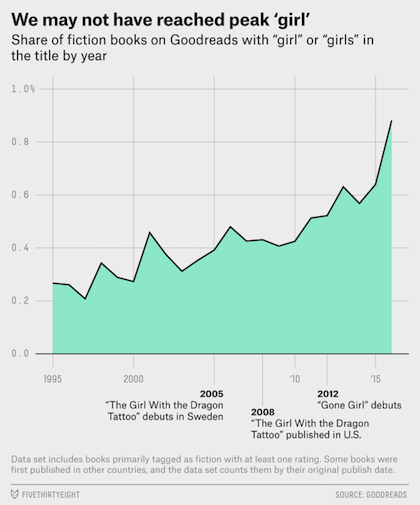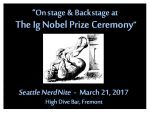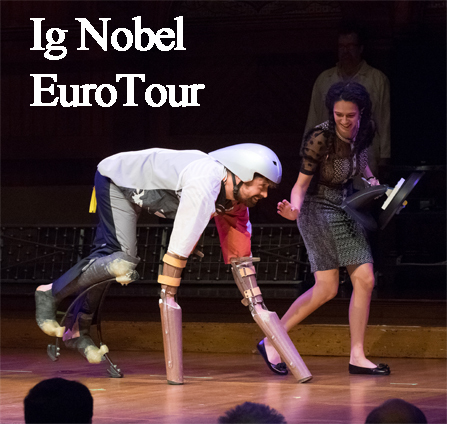Marc Abrahams's Blog, page 225
March 16, 2017
Ig Nobel at Imperial College London, Friday evening
The big Ig Nobel show at Imperial College London happens Friday evening, March 17, 2017, starting at 6 pm.
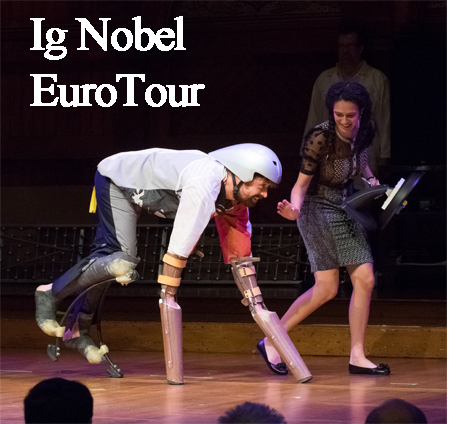 WHERE: IMPERIAL COLLEGE LONDON, UK — in The Great Hall, the Sherfield Building, South Kensington campus. TICKETS: The event is booked full.. But… some seats are likely to become available at the last minute or so. If you arrive at the Great Hall a bit early and take your chances, you just might be able to get a ticket.
WHERE: IMPERIAL COLLEGE LONDON, UK — in The Great Hall, the Sherfield Building, South Kensington campus. TICKETS: The event is booked full.. But… some seats are likely to become available at the last minute or so. If you arrive at the Great Hall a bit early and take your chances, you just might be able to get a ticket.
It features: Marc Abrahams / Ig Nobel Prize winners Raghavendra Rau (some business leaders acquire a taste for disasters that do not affect them personally), Thomas Thwaites (living as a goat), Elizabeth Oberzaucher (mathematical analysis of the man who fathered 888 children) / the QI Elves doing dramatic readings from bizarre-seeming research studies / David Kilgour explaining why Britain’s Ministry of Defence is so, um, efficient.
Details of that show and the entire Ig Nobel Spring EuroTour, are on our events page.

Towards an automatic branded-handbag recognition system
“Manufacturing branded handbags is a big business in the fashion world. Shoppers’ feedback showing photos of their purchased handbags in social networks or blogs is important for branding purposes. In this paper, we deal with handbag recognition.”
 So explain researchers Yan Wang, Sheng Li and Alex C. Kot of the Rapid-Rich Object Search (ROSE) Laboratory, at the School of Electrical and Electronic Engineering, Nanyang Technological University, Singapore. The team used Convolutional Neural Networks (and other algorithms) on (what is believed to be) the first handbag datasets constructed for branded handbag recognition.
So explain researchers Yan Wang, Sheng Li and Alex C. Kot of the Rapid-Rich Object Search (ROSE) Laboratory, at the School of Electrical and Electronic Engineering, Nanyang Technological University, Singapore. The team used Convolutional Neural Networks (and other algorithms) on (what is believed to be) the first handbag datasets constructed for branded handbag recognition.
“The experimental results show that our method performs very well on recognizing handbags. In our future work, more elaborate patch partition methods are needed to deal with the nonrigid deformation of handbags.”
See: On Branded Handbag Recognition in IEEE Transactions on Multimedia (Volume: 18, Issue: 9, Sept. 2016)
Also see: Horse recognition and Cow recognition.

March 15, 2017
Luxuriant Flowing Hair Club for Scientists™ announces when it will announce it’s 2017 Woman & Man of the Year
The Luxuriant Flowing Hair Club for Scientists (LFHCfS) proudly announced its 2017 Man Of The Year back in January. Now it proudly announces WHEN it will announce the 2017 Woman of the Year.
2017 MAN of The Year – an Experimental Physicist at Case Western Reserve University, researching cosmic rays – was announced on Friday, January 13th from the stage at Arisia. His name is Prof. Corbin Covault.
(Learn more about Man-of-The-Year Corbin Covault).
2017 WOMAN of The Year will be announced on March 24th at the University of Oslo Ig event (4:00pm start time). She will be there to display her luxurious flowing hair, and to make any remarks she wishes to make about her research, her hair, and what she thinks of the Woman of the Year title.
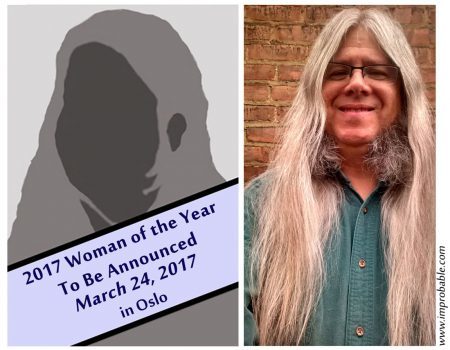
Only The 5th Time Awarded
The Woman and Man of the Year titles have each been given only 4 times before – in 2002/3, 204/5, 2015, and 2016. Details on all past honorees are available in the LFHCfS website.
Scientists with luxuriant hair have been with us for millennia. Find more details on club members, on the Historical Honorary Members, and on how to become a member yourself, all in the LFHCfS website.

Luxuriant Flowing Hair Club for Scientists™ announces when it wll announce it’s 2017 Woman & Man of the Year
The Luxuriant Flowing Hair Club for Scientists (LFHCfS) proudly announced its 2017 Man Of The Year back in January. Now it proudly announces WHEN it will announce the 2017 Woman of the Year.
2017 MAN of The Year – an Experimental Physicist at Case Western Reserve University, researching cosmic rays – was announced on Friday, January 13th from the stage at Arisia. His name is Prof. Corbin Covault.
(Learn more about Man-of-The-Year Corbin Covault).
2017 WOMAN of The Year will be announced on March 24th at the University of Oslo Ig event (4:00pm start time). She will be there to display her luxurious flowing hair and to make any remarks she wishes to make about her research, her hair, and what she thinks of the Woman of the Year title.

Only The 5th Time Awarded
The Woman and Man of the Year titles have each been given only 4 times before – in 2002/3, 204/5, 2015, and 2016. Details on all past honorees are available in the LFHCfS website.
Scientists with luxuriant hair have been with us for millennia. Find more details on club members, on the Historical Honorary Members, and on how to become a member yourself, all in the LFHCfS website.

March 14, 2017
Girls in books, statistically
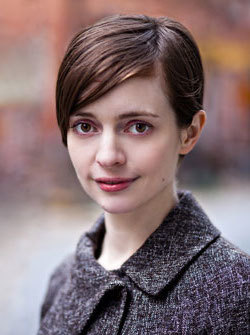 Emily St. John Mandel [pictured here], a former girl, who writes books, analyzed data about the many of the characters who are specifically identified as a “girl” in the title of a book. Mandel wrote up her findings for the FiveThirtyEight web site:
Emily St. John Mandel [pictured here], a former girl, who writes books, analyzed data about the many of the characters who are specifically identified as a “girl” in the title of a book. Mandel wrote up her findings for the FiveThirtyEight web site:
“The Gone Girl With The Dragon Tattoo On The Train — Why are there so many books with “girl” in the title?” by Emily St. John Mandel.
Who are these girls? Why are there so many of them? Books with “girl” in the titles make up a tiny fraction of all the books published in a given year, but they appear again and again on the bestseller lists. Other people have written about this trend, often with great eloquence, but none of them were backed by a data set. Using the database at Goodreads, the popular social networking website for readers, we set out to change that. A number of patterns emerged in our analysis: The “girl” in the title is much more likely to be a woman than an actual girl, and the author of the book is more likely to be a woman. But if a book with “girl” in the title was written by a man, the girl is significantly more likely to end up dead….
(Thanks to John Tyska for bringing this to our attention.)

March 13, 2017
Generalizing Keeler’s theorem (a.k.a. The Futurama Theorem)
Theorem 1. Let n ∈ N, n ≥ 2. The inverse of any permutation in Sn can be written as a product of distinct transpositions in Sn+2 \ Sn.
Mathematically inclined aficionados of the cult animation series Futurama will no doubt recognise the theorem above – it was first posited by Ken Keeler in the 2010 Writers Guild* Award-winning episode ‘The Prisoner of Benda’.
“
Professor Farnsworth and Amy build a machine that can swap the brains of any two people. The two use the machine to swap brains with each other, but then discover that once two people have swapped with each other, the machine does not swap them back. More characters get involved until the group is thoroughly mixed up, and they start looking for ways to return to their own heads.”
– explain researchers Jennifer Elder and Professor Oscar Vega [pictured] at the Department of Mathematics, Fresno State University, US.
“Clearly, the problem of undoing what the machine has done may be studied using permutations; each brain swap can be described by a transposition in Sn, where n is the number of characters involved in the brain-swapping.”
As a result of their permutational analyses, the team conclude that :
“ – as long as the brain-swapping machine Professor Farnsworth and Amy build swaps a prime number of brains cyclically, they can always fix the chaos created by incorporating enough extra characters to the mix.”
Their paper ‘Generalizing the Futurama Theorem’ in arXiv:1608.04809v1 [math.GR] can be read in full here.
* Note: The Writers Guild is officially apostrophe-less.

March 12, 2017
The RAT Trace, the CAT Trace, and the MAN Trace
 Say “rat”, say “cat”, and say “man”. Then read this study, if you want to:
Say “rat”, say “cat”, and say “man”. Then read this study, if you want to:
“Phonological similarity and trace degradation in the serial recall task: when CAT helps RAT, but not MAN,” Anthony B. Fallon, Kim Groves, and, Gerald Tehan, International Journal of Psychology, vol. 34, nos. 5/6, 1999, pp. 301-307.
The photo, warped though it appears to be, is of co-author Tehan.
BONUS: But, but, but… if you feel you are stuck in a rat race, yet you yearn to know more about rat traces, try this study: “Amphetamine, 3, 4-methylenedioxymethamphetamine, lysergic acid diethylamide, and metabolites of the catecholamine neurotransmitters are agonists of a rat trace amine receptor,” James R. Bunzow, Mark S. Sonders, Seksiri Arttamangkul, Laura M. Harrison, G. E. Zhang, Denise I. Quigley, Tristan Darland et al., Molecular Pharmacology 60, no. 6 (2001): 1181-1188.

March 11, 2017
Seattle NerdNite talk on the Ig Nobel Prize, March 21st
If you will be in Seattle on March 21st then head to the High Dive bar in Fremont to hear Ig Nobel Co-Producer David Kessler give a NerdNite talk: “Onstage & Backstage at The Ig Nobel Prize Ceremony”.
David will try to describe The Ig Nobel Prize and also some of the interesting people and stories behind it.
He will also ask the audience whether anyone in the room meets the strict criteria to join the LFHCfS.
6:30pm Doors open (happy hour)
7:30pm Talks begin
$5 cover charge
High Dive 513 N 36th Street, Seattle
NerdNite talks delve into interesting topics in venues that also serve alcohol:
“We all know that learning is more fun when you’re drinking with friends and colleagues. Thus, Nerd Nite is a monthly event held in more than 90 cities across the globe during which several folks give 18-21-minute fun-yet-informative presentations across all disciplines
– while the audience drinks along.”
NOTE: If you cannot attend this event because you will be in Europe, you might be interested to hear Ig founder Marc Abrahams presenting that same week in England, Norway, and Sweden (and later in Austria, Italy, The Netherlands, and Scotland)
ANOTHER NOTE: If you would like to see a video of the Ig Nobel Prize Ceremony (paper airplanes and all) you can find one – the 2016 ceremony – immediately below, and many more in the Improbable Research YouTube Channel.

Why I hate an empty bus stop
Rafael Prieto Curiel, in the mathematics magazine Chalkdust, does some rough calculations about waiting for a bus:
“Let’s measure how much time I expect to wait for the next bus to arrive as I observe more or fewer passengers in the stop…. If I find zero passengers at the bus stop, 99% of the time I will have to wait more than 15 minutes for the next bus. However, if I arrive at the bus stop and I find 25 or more passengers, then 99% of the time I have to wait less than 6 minutes for the next bus! Rarely, very rarely, I will find an empty stop with the next bus nearby, therefore, I prefer a crowded stop and then I just cross my fingers hoping that the bus is not too crowded too…. Next time I arrive at a bus stop that doesn’t have the “next bus in X minutes” I can simply count the number of passengers waiting at the stop and obtain a fairly good estimate of my expected waiting time.”

March 10, 2017
Ig Nobel Spring EuroTour: The Schedule
This year’s Ig Nobel Spring Eurotour is near upon us:
— NOTTINGHAM TRENT UNIVERSITY, UK — March 15
— IMPERIAL COLLEGE LONDON, UK — March 17
— EPFL, Lausanne, Switzerland — March 21
— UNIVERSITY OF OSLO, Norway — March 24
— STOCKHOLM UNIVERSITY, Stockholm, Sweden — March 27
— KAROLINSKA INSTITUTE, Stockholm, Sweden — March 27
— FRI TANKE FÖRLAG, Stockholm, Sweden — March 27
— ORF (television), Vienna, Austria — March 28
— UNIVERSITY OF GRAZ, Austria — March 29
— UNIVERSITY OF CATANIA, Italy — April 6
— NATUURHISTORISCH MUSEUM ROTTERDAM, The Netherlands — April 8.
— EDINBURGH, Scotland. Details TBA.
Shows will feature MARC ABRAHAMS (founder of the Ig Nobel Prize ceremony) and different combinations of these Ig Nobel Prize winners:
MINNA LYONS (psychopaths and night owls)
KADER ALLOUNI (using speed bumps to diagnose appendicitis)
ELIZABETH OBERZAUCHER (mathematical analysis of the man who fathered 888 children)
RAGHAVENDRA RAU (some business leaders acquire a taste for disasters that do not affect them personally)
THOMAS THWAITES (living as a goat)
LUDWIG HUBER (absence of contagious yawning in tortoises)
ALESSANDRO PLUCHINO, ANDREA RAPISARDA, CESARE GAROFALO (organizations would become more efficient if they promoted people at random)
HYNEK BURDA (defecating dogs align their body axis with Earth’s north-south geomagnetic field lines)
NADIA DOMINICI (walking on water, on the moon)
KEES MOELIKER (homosexual necrophilia in the mallard duck)
PIERS BARNES (how many group photos are needed to ensure at least one in which nobody blinks)
FREDRIK SJÖBERG (three-volume autobiographical work about the pleasures of collecting flies that are dead, and flies that are not yet dead)
LAURENT BÈGUE (people who think they are drunk also think they are attractive)
MARINA DE TOMMASO (measuring the relative pain people suffer while looking at an ugly painting, rather than a pretty painting, while being shot [in the hand] by a powerful laser beam)
Additional SURPRISING PERSONS AND THINGS will appear, here and there.
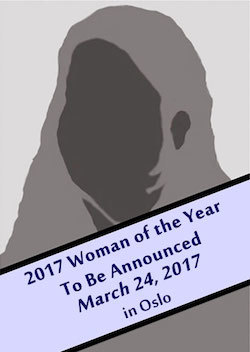 HAIR NOTE: The show at the University of Oslo, on Friday, March 24, will include the public introduction of the Luxuriant Flowing Hair Club for Scientists (LFHCfS) Woman of the Year. [Also: There will be a hair-centric, brief press event earlier that day, in Oslo.]
HAIR NOTE: The show at the University of Oslo, on Friday, March 24, will include the public introduction of the Luxuriant Flowing Hair Club for Scientists (LFHCfS) Woman of the Year. [Also: There will be a hair-centric, brief press event earlier that day, in Oslo.]
INCOMPETENCE NOTE: The tour will feature tributes to the Ig Nobel Prize-winning (in the year 2000) study of the Dunning-Kruger effect. That study is called “Unskilled and Unaware of It: How Difficulties in Recognizing One’s Own Incompetence Lead to Inflated Self-Assessments.”
LIVECAST: The Stockholm University show will be livecast.
DETAILS (which will be updated if/as details change) are on the Improbable Research events page.

Marc Abrahams's Blog
- Marc Abrahams's profile
- 14 followers


